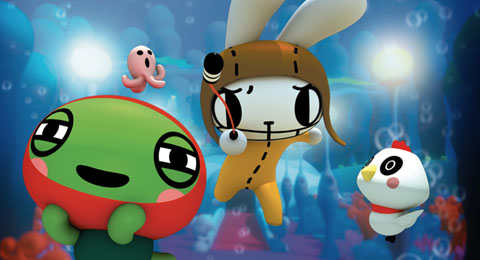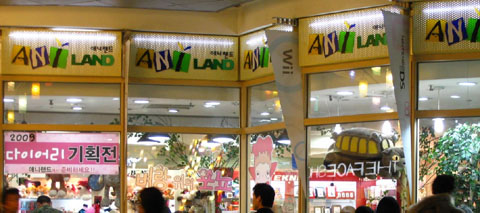

My Trip To Korea

I just got back from Seoul, Korea, where I spoke at a conference called DICON 2009, a digital conference that was part of the International Creative Content Fair. I liked that this event had its own slogan, “Show the Spirit of Creative Content!” since I rarely attend events that have slogans these days. I don’t think the Ottawa Festival has a slogan. I can only imagine what it would be. (“Sit down, shut up, listen to Chris?”)
While at DICON, I gave a presentation on the elements of quality cartoons. I was happy they had asked about that particular topic since it’s a fun topic to talk about. No one in the US seems terribly interested in pondering this anymore. I guess we have it all figured out here.
The Korean animation industry is an interesting case study. After years of doing service work for the US, Canada and Europe, throughout the 2000s, the animation industry in Korea shifted its attention to creating cartoons. Schools added programs in animation, and beautiful, moody Korean short films began showing up in festivals worldwide. Within a matter of years, original Korean series began showing up on the air in Korea.
The Korean animation industry’s most recent focus has been how to sell these cartoons outside of Asia. It is hard to sell to the US, even for people who live here, I assured them. There’s not a lot of space on the air and there are a lot of shows out there.
The American animation industry has a long and interesting relationship with the Korean animation industry. Through the 1980s and 90s, a great deal of animation service work was sent to Korea. Most animation executives, creators and producers participated in a particular rite of passage, a trip to Korea to visit the production studios. Reeling from jet lag, you would then have the surreal experience of seeing hundreds of people you had never met sitting and drawing or painting various series you worked on. Actually, some would be working on your series, and the people next to them would be working on series for rival networks, which would make it even more surreal.
I was always impressed with the work of the studios we worked with, Rough Draft, Yeson, Sae Rom, and several others. I remember thinking over the years that it was just a matter of time before these animators and studios would want to create original content, shows in Korean that they could watch on the air. By the early 2000s, much of the Korean animation industry had jumped head first into the murky waters of intellectual property development, along with a great deal of help from the Korean government, by way of KOCCA, the Korea Creative Content Agency.
The focus on service work had come out of a long history of Korean manufacturing. Conversely, the desire to create and own intellectual property probably came more from the marketing and publishing areas of Korean business and the desire to own the rights to the series they are producing, as well as the honor of seeing these Korean series get sold internationally.
I have met several newer studios over the years, through pitches and visits, and I have always sensed that frustration you have when you first start out doing something and you want everyone to appreciate what you are doing right away. I got a sense that the Korean government was looking at the American and Japanese industries and wondering why after six or seven years, Korea’s animation industry hadn’t caught up yet.
I have taken a number a pitches from these Korean studios over the years and one thing has been consistent — the amazing artwork. They make CGI look effortless and almost each show I’ve seen features amazing artwork. Direction and design in the pilots I look at is always topnotch.
However, I have watched a number of pilots wondering whether I’d watched something with a plot or characters, or just a study in movement. I often feel the same way watching Japanese animation, and I’ve always chalked it up to the idea that the way Japanese animators tell stories is just different from the way we westerners tell stories. No problem, I’d think, every culture deserves to have a national film style. But the issues kick in when the Korean studios want to sell these series to the US, Canada and Europe. Some of their series that remind me of independent films, but then I see they are targeted to preschool or 6-8 audiences. I guess that’s why we were invited there to give our speeches.
There was a mix of speakers from the US at DICON: Max Howard, David Voss from Mattel, Christopher Skala of HIT, Josh Selig of Little Airplane, Brian Konietzko and Seung Hyun Oh of Avatar: The Last Airbender, and a long list of other speakers from Asia and Europe. I did my session with Celine Chesnay from France Television. Kevin Rafferty, the well known feature film visual effects supervisor gave a keynote speech along with Rintaro (aka Shigeyuki Hayashi), the Japanese director of Galaxy Express 999 and Metropolis.
They didn’t just cover the film and television industries. Other sessions focused on mobile and internet content, social networking, co-productions, financing, and the music industry.
For my speech, I did walk through a long list of things you must do to make a cartoon a good cartoon. After my presentation, I received a number of smart and well-thought-out questions. The most direct was, “be honest, what do you think are the weaknesses of Korean animation?” I said what I’d been saying right along, “You create amazing artwork here and direction is always great. You need to focus on character and story.” A few of the studios pointed out they had hooked up with British writers. That’s a start, I suppose.
All in all, it was a fun trip. There was a store called Aniland right near the hotel, with Totoro right on the sign next to the store’s logo. I bought some great toys for my kids. The Korean aesthetic is all about extreme cuteness. Their toys and designs are even cuter than Japanese characters. That’s good news if you have a four-year-old daughter. I bought all the toys from vending machines that looked like gumball machines. We have a good collection of Tofu-head magnets now.
However, I slept no more than ten hours in three nights so I have been spending the week catching up on that all important sleep.


